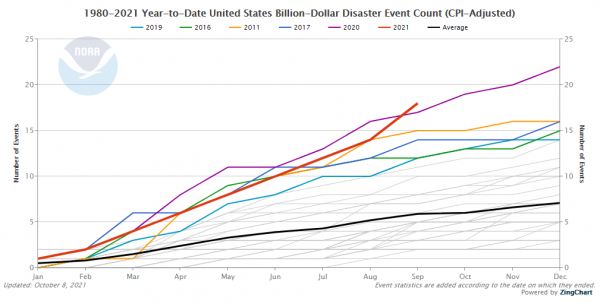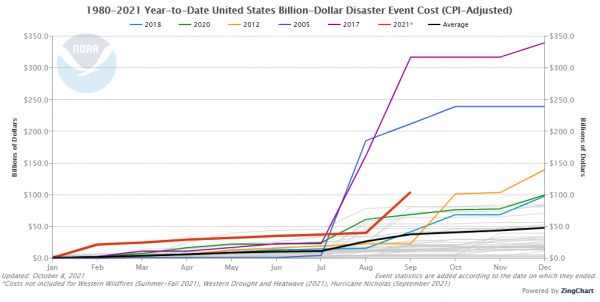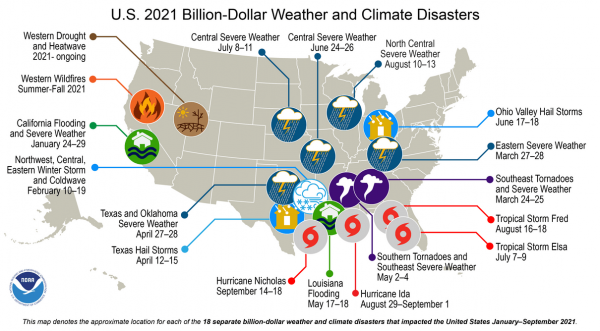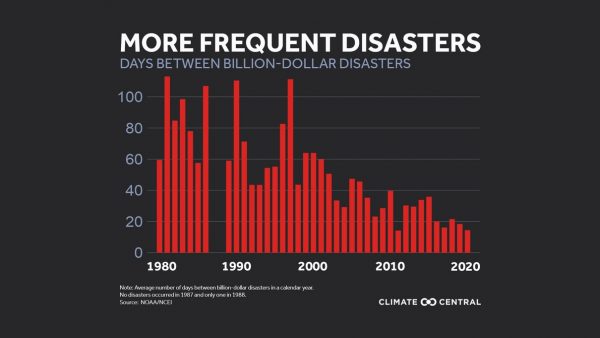By Kenny Stancil, staff writer at Common Dreams. Originally published at Common Dreams
The National Oceanic and Atmospheric Administration announced Tuesday in its latest monthly report that the United States endured 18 “billion-dollar weather and climate disasters” through the first nine months of 2021, putting this year on pace to be among the worst for such catastrophes.
For decades, scientists have sounded the alarm that extreme weather would become more frequent and intense amid the fossil fuel-driven climate emergency. With 18 calamities costing at least $1 billion already on the books and three months to go, 2021 is second only to 2020, when there were 22 such events.
Before it was surpassed last year, the previous annual record for billion-dollar disasters was 16—reached in 2011 and matched in 2017. While last year saw a greater number of billion-dollar disasters, 2021 is outpacing 2020 through September.

Furthermore, although not all of the destruction has been calculated, this year’s events have already proven more expensive, causing $104.8 billion in damages compared with $100.4 billion in 2020. The costliest years to date are 2017 and 2005, when Hurricanes Harvey and Katrina devastated Houston and New Orleans, respectively.

Communities across the nation have been ravaged by a variety of extreme weather events in 2021, which have resulted in the deaths of 538 people.
Some of the most notable billion-dollar disasters that occurred between January and September include the winter storm that wrecked Texas’ isolated, deregulated, and fossil fuel-dependent power grid, causing dozens to freeze to death; relentless Western drought, heatwaves, and wildfires that have burned nearly 6.5 million acres to date and killed over two hundred people; and the highly destructive Hurricane Ida, which barreled into the Gulf Coast’s extensive petrochemical infrastructure, leaving dozens of oil spills in its wake, and also pummeled the Northeast, adding more casualties.

Just as climate scientists have warned it would, unmitigated greenhouse gas pollution is producing higher temperatures and more extreme weather—leading to more and more catastrophic events.
Since NOAA started keeping such records in 1980, the U.S. has been hammered by 308 billion-dollar disasters, claiming 15,030 lives and costing roughly $2.1 trillion—with annual averages of just over seven events, 358 deaths, and approximately $50 billion in damages.
The average number of annual billion-dollar disasters has skyrocketed from about three events nationwide per year in the 1980s to more than 12 events per year in the 2010s. The average number of annual deaths has also increased over the decades, from 287 per year in the 1980s to 522 per year in the 2010s.
From 2016 to 2020—the five hottest years on record—there were more than 16 separate billion-dollar disasters per year, on average. Combined, the 81 events killed nearly 4,000 people, or more than a quarter of the death toll since 1980, and cost $640.3 billion, accounting for over 30% of the 40-year financial toll.
Researchers at Climate Central recently pointed out that the growing frequency of calamitous events “can strain the resources available for communities to recover quickly and manage future risks.”
According to their new analysis, the average time between billion-dollar disasters has declined from 82 days in the 1980s to just 18 days on average in the past five years (2016-2020).

Climate Central argued that NOAA’s “staggering figures primarily reflect direct impacts on assets (including damage to homes, crops, and critical infrastructure) and therefore don’t reflect the full toll of disasters—including on human health and well-being, displacement, food and water supplies, as well as loss of cultural heritage, biodiversity, and habitats.”
“Nor do these figures convey the disproportionate impacts of disasters on people in poverty or the need for equitable allocation of federal disaster assistance in accordance with social vulnerability,” the group added.
And the U.S. is far from alone in experiencing an uptick in extreme weather events, which are also decimating impoverished nations around the globe.


The case for radical change keeps mounting. By that, I mean that radical changes are coming if we like it or not, so it might be smart to make adjustments now to soften the landing.
And the case against continued GDP growth keeps spreading. Jeremy Lent, author of The Patterning Instinct, had an article in Salon over the weekend. He directly confronts the Ecomodernists’ claim that Green Growth is possible, i.e. GDP growth can be decoupled from carbon emissions:
That paragraph contains two links to studies backing up Lent’s contention.
All three are worth checking out.
There are many advocates for ‘green growth’ commenting on this site. I expect we will see their response shortly. So far as I understand it, the notion has been completely debunked: it does not and can not exist. Sadly, virtually all economists, politicians (including many Greens) and the media are so deeply wedded to economic growth as the only measure of national success that it will take a lot more than just science to convince them to change, if they ever will.
Of course, advocates for degrowth must take care to also advocate for justice for the Global South, whose historical emissions lag so far behind the North’s that they must be given all they need to make a decent life for their peoples. I can’t see that happening when the $100bn of climate aid promised by the North has mostly not materialised while they spend up to $2tn annually on their military forces.
It seems to me there are two main forces operating here. The first is the one I’ve already mentioned: a system whose goal is maximizing profit, i.e. return on capital and debt service for creditors. These are powerful people, and they usually get their way, even if most of them are deluded fools with a perverted view of what life is about.
The second problem requires us to point a finger at ourselves. Since Jimmy Carter had his toe scalded when he put his toe in the water to test whether Americans would pull together and reduce gasoline consumption, politicians in the WEIRD countries have avoided any talk of ending the fossil fuels party.
The second problem really has to be tackled before the first. No politician is going to stand up to those who benefit from Business As Usual until there is a substantial change in the citizenry. Mainstram media, already owned by the beneficiaries of BAU, is not of much help, though at least Lent has moved the discussion to the “pages” of Salon. Your point about the Global South makes this even more challenging because once acknowledged, it’s clear as a matter of justice however measured, that we WEIRDos have a lot of cutting to do.
That’s why I’ve been saying for some time that three outcomes loom: Mad Max if BAU is allowed to run out until it ends itself; totalitarianism; or a deep and very widespread change in worldview concentrated in the Global North where it’s most needed. The author of this article, Lent, is one of the growing number of people working on that, but it’s essential to battle against the flood of well-funded propaganda from people trying to preserve their rice bowls.
Perhaps I am remembering it wrong but back in the 80s, I had the firm impression that when they were talking about future climate change due to the build up of smog and CO2, that most of the effects would be really only experienced by third world countries. If I am remembering it correctly, then this may have been deliberately done by petrochemical corporations to get people not to worry about it so much.
A lightning strike caused conflagration such as our now in the mop up stages nearly 90,000 acre KNP Fire, isn’t unusual this time of year and there have been quite a few in Sequoia NP, but none of this size, and imagine fighting a fire in 1936 w/o aerial support?
I watched a conquering army of firefighters, aerial assault strike forces, support staff and the whole nine yards descend upon the ‘job site’, over 2,000 assembled and platooned to various battle stations, everything screamed spendy, what does it cost in total from beginning to end to put it out?
The knock on effect is that Sequoia NP will be closed until the spring, and short term vacation rentals will feel the brunt of the burnt along with Tulare County which took it’s tithe of the action.
We’re kind of the parking lot @ Disneyland, but if the latter is closed, nobody goes there.
My thinking is that WA is the only state with water resources and without wind/water/fire destruction events.
” WA … without wind/water/fire destruction events.”
With notably rare exceptions.
It’s disingenuous to measure the frequency of disasters by reference to a fixed dollar value threshold, even with CPI adjustment.
Increasing population, development, density, home size etc. all ensure that disasters will be more expensive in dollar terms for any given event over time.
Nearly everything you read about climate change these days includes some spin or other like this. Increased heat related deaths with no mention of the greater number of cold deaths avoided. Numbers of people exposed to increased water stress with no mention of the greater number of people benefiting from reduced water stress. And those poor polar bears that are heading for extinction – there were 10,000 odd back in 1950 and now there are only 40,000 left!
In addition forest fires being classified as a climate disaster when they should be classified as a man made disaster. If the forests were left in their natural state, you would have normal small fires such as those that many of the trees have become adapted to. Instead we put out small fires, however, we do this without clearing and maintenance. So we get giant fires. Global warming makes it a little worse and now it’s a climate disaster.
Yes, and I think that applies to economic cycles too. Every time there is a cyclical slowdown we push buttons and pull levers to pump up the spending and printing and let the zombies live another day. It seems to make sense in the short run, but in the long run you just set yourself up for the giant fire!
I’m not sure this is true in the areas above the Arctic circle where permafrost is melting. Lightning did not used to be a significant issue in those areas, plus the methane released from the permafrost is conducive to fires. These changes appear to be related to climate change.
That was what I thought too. Depending on how you count, the US GDP grew at least 3 times between 1980 and 2020 so it’s natural to expect more billion-dollar disasters.
This argument doesn’t depend on the GDP growth being real or not, as long as the same dollars are used for estimating disaster costs.
https://www.cbsnews.com/media/top-10-safest-us-cities-from-natural-disasters/
Don’t want to live in any of these… and of course there could be a pay to play deal with the list.
Dayton Ohio? wouldn’t the Xenia tornado count as part of Dayton’s risk factor?
There are two implicit questions in this. How much of the losses/damage is insured and how much born by citizens? Will states let insurance rates, both private insurance and FEMA for flood, rise to the level required by the increased risk?
I know the insurers are very concerned and acting — not just raising rates, but changing coverage terms and simply no longer covering certain things or properties.
What ever is not privately insured means the government pays for it. When FEMA proposed raising rates to reflect the risks people went bananas.
As they say, denial is not a river in Egypt
Back in the day insurance typically paid about half of the damages. For instance in 1975 I lived in Omaha NE when we had a major tornado in May. Approximately 2,000 homes and buildings were destroyed and only 50% of those buildings were insured.
Not sure what it is today but I bet the uninsured rate for property owners isn’t too far from that number.
it strikes me that some of those billion dollar disasters wouldn’t have reached that level had they occurred in 1980, when building prices were a tenth of what they are now…
likewise, the increase in the average number of annual deaths has pretty much matched population growth over the same span…